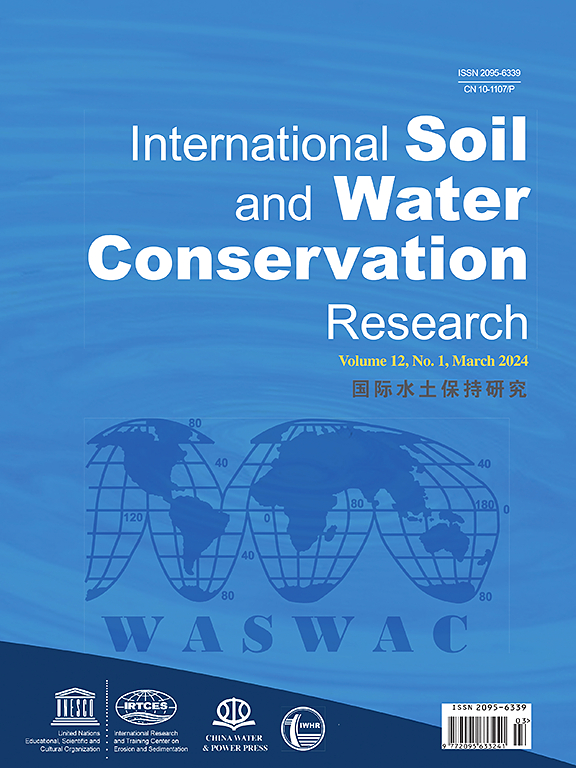自动量化等高线,作为改进山脊土壤侵蚀估算的辅助方法
IF 7.3
1区 农林科学
Q1 ENVIRONMENTAL SCIENCES
International Soil and Water Conservation Research
Pub Date : 2024-07-20
DOI:10.1016/j.iswcr.2024.07.001
引用次数: 0
摘要
采用等高耕作等水土保持措施可以减少耕地的土壤流失。在通用土壤流失方程(USLE)的经验模型中,这些措施都被考虑在支持实践管理的 P 因子中。在应用过程中,通常缺乏足够的数据或合适的方法来准确确定具体地块分析中的 P 系数。在本研究中,我们展示了在典型应用范围内为每个地块推导单独 P 因子所需的工作和益处。为此,我们将快速线条检测算法应用于 2016 年 5 月谷歌地球在德国低山地区的开放式遥感数据。该算法从轮胎痕迹和种子行中检测出线条,从而确定每个地块的主要耕作方向。在 26 种不同作物的 2495 块土地上,成功率为 94.9%。结果表明,在考虑大量地块时,自动方法在时间上有很大优势。随后,我们利用获得的详细信息,采用德国 DIN 19708 标准计算了德国地区条件下的 P 系数,其次还采用了基于修订的 USLE 方法。很明显,由于坡度和坡长的计算公式和有效范围不合适,且未考虑山脊和偏离地面的等高线,现行德国标准无法以必要的详细程度适用于本次低山脉研究中 78.1% 的地块,因此需要对其进行修订,以避免在应用中受到限制。本文章由计算机程序翻译,如有差异,请以英文原文为准。
Automated quantification of contouring as support practice for improved soil erosion estimation considering ridges
Using soil conservation practices such as contouring are able to reduce soil loss on arable land parcels. In the empirical model of the Universal Soil Loss Equation (USLE), these measures are taken into account by the P-factor for support practice management. In the context of application, there is usually a lack of sufficient data or suitable methodology to accurately determine the P-factor within a plot-specific analysis. In this study, we demonstrate the effort and benefit of deriving an individual P-factor for each land parcel within a typical application scale. For this purpose, we apply the Fast Line Detector algorithm to open remote sensing data of Google Earth from May 2016 in German low mountain range. The algorithm detects lines from tire tracks and seed rows, which allows to determine an individual main cultivation direction for each land parcel. The success rate was 94.9 % for 2495 land parcels with 26 different crops. The results show a major time advantage for the automated method when considering a large number of parcels. Subsequently, we used the detailed information obtained to calculate the P-factor under regional German conditions using the German standard DIN 19708 and, secondly, an approach based on revised USLE. It is apparent that the current German standard cannot be applied with the necessary level of detail for 78.1 % of all land parcels in this low mountain range study due to unsuitable equations and validity ranges for slope steepness and length and a non-consideration of ridges and off-grade contouring and therefore needs to be revised to avoid being restricted in its application.
求助全文
通过发布文献求助,成功后即可免费获取论文全文。
去求助
来源期刊

International Soil and Water Conservation Research
Agricultural and Biological Sciences-Agronomy and Crop Science
CiteScore
12.00
自引率
3.10%
发文量
171
审稿时长
49 days
期刊介绍:
The International Soil and Water Conservation Research (ISWCR), the official journal of World Association of Soil and Water Conservation (WASWAC) http://www.waswac.org, is a multidisciplinary journal of soil and water conservation research, practice, policy, and perspectives. It aims to disseminate new knowledge and promote the practice of soil and water conservation.
The scope of International Soil and Water Conservation Research includes research, strategies, and technologies for prediction, prevention, and protection of soil and water resources. It deals with identification, characterization, and modeling; dynamic monitoring and evaluation; assessment and management of conservation practice and creation and implementation of quality standards.
Examples of appropriate topical areas include (but are not limited to):
• Conservation models, tools, and technologies
• Conservation agricultural
• Soil health resources, indicators, assessment, and management
• Land degradation
• Sustainable development
• Soil erosion and its control
• Soil erosion processes
• Water resources assessment and management
• Watershed management
• Soil erosion models
• Literature review on topics related soil and water conservation research
 求助内容:
求助内容: 应助结果提醒方式:
应助结果提醒方式:


